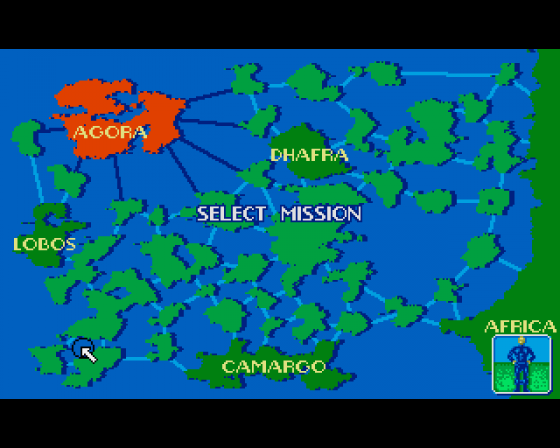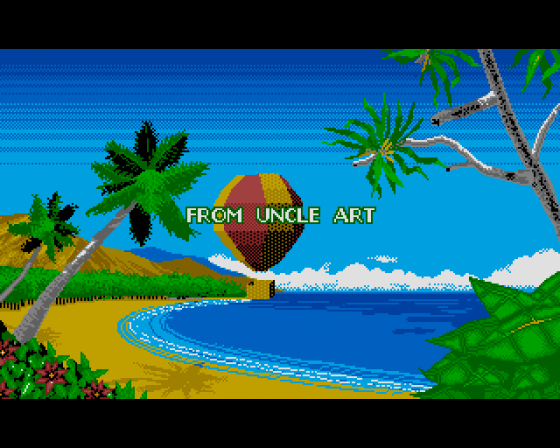
Amiga Power
 1st October 1991
1st October 1991
Categories: Review: Software
Author: Matt Bielby
Publisher: Rainbird
Machine: Amiga 500
Published in Amiga Power #6
The long, long (long) awaited sequel to Mike Singleton's Midwinter is finally with us. It's bigger than the first game, more ambitious and irons out a number of the rough edges - but is it really any more fun to play?
Midwinter 2: Flames Of Freedom
The thing about Mike Singleton games - Mike being the guy behind 8-bit classics like Lords Of Midnight and Doomdark's Revenge, as well as War In Middle Earth and, of course, the first Midwinter - is that people either love 'em or hate 'em. People who love them tend to be real strategy wargame buffs - Lords Of Midnight worked brilliantly as a (ahem) 'strategy experience', totally ignoring any action elements, and probably remains his best game. The problem strategy buffs find with things like Midwinter, with its glossy, presentation, sexy front end and inclusion of action sequences, is that you tend to get bogged down in the action stuff - which isn't all that brilliant anyway as action sequences go - and the strategy suffers.
Action fans would have a different complaint. They want to drive all these vehicles, meet all these people and so on - attracted by the big name and sheer polish of the game - only to find there was this unfathomable wargame thing hidden just below the surface.
Which leaves the Midwinter series aimed at... who? Well, a group of real Renaissance games players, I guess, people who like lots of types of game and aren't scared of something that mixes a few together. People like a lot of folk in the Amiga Power office in fact, which makes it rather worrying that nobody here's getting very excited at all about the 'new improved' Midwinter: Flames Of Freedom. In actual fact, we all find it rather dull. But I'm getting ahead of myself.

First impressions count for a lot, and you can't fault Flames for presentation. The whole package feels nine tenths like some massive, high profile Hollywood blockbuster movie, one tenth like a heavyweight science fiction novel, and just generally well put together and meant - like many MicroProse games, this is something it's simply nice to own. Little things like re-occurring symbols - the twin dolphins of the Covert Operations Bureau, say - cropping up in a both packaging and program help instil a real sense of faith in the game itself, a long time before you've properly played it. If so many people - they're credited, movie-like, at the end of the book - have put so much effort into making this look its best, the game itself just has to be a corker, doesn't it?
And if you manage to ignore a number of problems - which I'll get to in due course - you have to admit that yes, this is a rather impressive game. It's large scale and ambitious for sure. Like the best sequels, it takes the concept of the first game (hopefully) puts right the things that were wrong with it, then just starts adding. And adding. And then, on top of all that, it adds some more. The playing area, number of characters depicted and range of transport and events is colossal - this is a game that promises to take months and months to complete, though thankfully it can be played in a much more actiony sort of a way too.
It manages to be very friendly and entertaining looking indeed when you first pick it up - simply messing about with the character generation screens, for instance (which allow you to change the characteristics and - yes! - facial features of the character you play) has given me some of the best fun I've had on a computer in ages.

Unfortunately though, it is - like its predecessor - a game stuck between two stools. The presentation, use of soap opera-style personalities and so on, all lead you to expect a really accessible game, one that will open up the strategy genre to, if you will, the masses.
However, its size and slowness work against it. There's simply too much running around, too much travelling, too much ground to cover and too much waiting around between screens for something to happen to please the layman. The game may have improved on the first one by 200 percent in this area, but it still isn't quick enough on its feet for real mass appeal. For most of us, it's one of those tragic games that sounds like it'll be a lot more fun to play than it actually is.
It's also a game that's packed with what is, for me, an annoying number of inconsistencies, illogicalities and bits that downright don't make sense - things that help destroy the carefully built-up feeling of reality. Here's a short list of some of the more obvious ones so you can see what I mean.

1. I'll accept that it's a Good Thing that your character can now commandeer any available vehicles he (or she) comes into contact with (you couldn't in the first game) but it would have been much neater if this had been done with a bit more internal logic. I can just about credit that a man on foot could leap onto a moving jeep or even tank if he was nippy/lucky, but a low flying Zeppelin? Or a helicopter? I think not. (And then once he's miraculously got on board we're meant to assume... what? That the crew of this tank/helicopter/Zeppelin/ship just bail out and run away? It's not explained by the game, that's for sure).
2. Though the date is given as 2138, in look, fashion and general 'feel' the technology level seems to be that of the present day. There are tanks and jeeps and trucks and buses and speedboats, fine, but then we get to the flying machines and things get weird. Helicopters, yes - but biplanes and Zeps?
Why is flying technology whizzed back to 1914, while everything else remains the same? And where's this bloody 'flying submarine' come from? It can travel across both land and sea, underwater and through the air apparently and seems about 300 years out of sync with the rest of the game.

3. Even in the middle of a fire-fight, with hundreds of tanks and planes shooting at you it's possible to choose the 'rest' option - at which point you'll curl up in a little ball on the floor, and, erm, go to sleep. Now I would have thought this was most unwise - and anyway, with all that noise going on you're likely to get little kip - but apparently not.
Most of the time no-one will capture you or kill you, and you'll be able to get up refreshed in five hours time (or whatever) and continue your mission.
4. Most missions would be total nonsense in the real world. Here's an example: on the island of Panao you've got to recruit the daughter of the police chief (he dotes on her, and if she's with you will do his best to bring all the police over to your side), the wife of the military commandant (he hates her nagging so will bring all the army with him to prevent it) and - suddenly! - you've got a revolution. Unlikely, isn't it?

Now it may seem clurlish to complain about such things, but the game's all over the place as far as these small logical details are concerned. I can see the perfectly valid gameplay reasons why some of these are there - particularly the getting into vehicles bit - but I'm not convinced there wouldn't have been a number of neater, more logical ways to cope with them all.
So what are we left with? Well, what to me is ultimately a sprawling, boring game, full of good things that don't add up to a satisfying whole. To others, it's no doubt a brilliantly challenging strategy action game, packed with lots to do and see - but these must be people with an incredible degree of patience. Fans of Midwinter will be in their element - they're getting more of the same, with a lot of the really tedious stuff taken out - but while it's undeniably big and epic, it also promises a lot more (certainly in terms of fun) than it delivers.
It's a game that would have been twice as good if there'd been fewer vehicles, a smaller number of islands, taks that made a bit more sense and (especially) some extra wit used to spice things up along the way. (Monkey Island has spoiled me - I can't interact with characters are boring as these are more.)

I can't help thinking that either (a) the same basic plot and structure might have worked better without the 3D action element at all, but with a boost to the character interaction side, adventure game-style, or (b) that the 3D would work better on a smaller, tighter game - something along the lines of Activision's Hunter, perhaps its nearest rival. As it is, it's big and has its moments, but will, I fear, appear to many people as something too predictable, sprawling and dull.
The Bottom Line
Uppers: There's lots and lots of it - thousands of characters, hundreds of islands, a wide selection of vehicles and oodles (and oodles) of 3D. It has to be a definite thumbs up as far as value for money is concerned, that's for sure.
Downers: Unfortunately, the giant strategy game structure remains too big and unwieldy, the 3D action sequences get in the way, there's far too much travelling, the character interaction gets repetitive, and it's full of odd little illogicalities.
In many ways supremely impressive, Flames Of Freedom will, I think, fail to work for many people. A game that's ultimately a lot less fun than it sounds.
Other Reviews Of Midwinter 2: Games Of Freedom For The Amiga 500
Midwinter II: Flames Of Freedom (Rainbird)
As Rainbird's cold war hots up, Paul Presley goes island-hopping.














